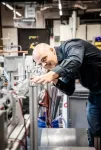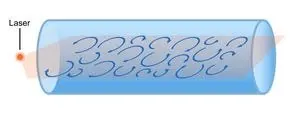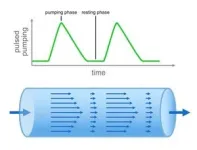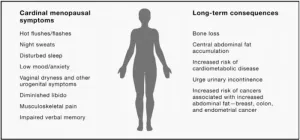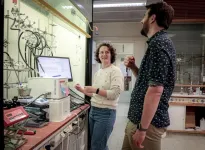(Press-News.org) Pumping liquids may seem like a solved problem but optimizing the process is still an area of active research. Any pumping application—from industrial scales to heating systems at home—would benefit from a reduction in energy demands. Researchers at the Institute of Science and Technology Austria (ISTA) now showed how pulsed pumping can reduce both friction from and energy consumption of pumping. For this, they took inspiration from a pumping system intimately familiar to everyone: the human heart.
According to an international study, nearly twenty percent of global electric power are used for pumping liquids around—ranging from industrial applications pumping oil and gas to heating installations pumping hot water in private homes. A team of researchers around Davide Scarselli and Björn Hof from the Institute of Science and Technology Austria (ISTA) looked for a way to reduce these energy demands, taking inspiration from nature. In a new study, now published in the scientific journal Nature, they showed that pumping liquids through a pipe in pulses—much like the human heart pumps blood—can reduce the friction in the pipe and therefore also the energy consumed.
Turbulent Friction
“Over the years, researchers and engineers have been trying to make pumping fluids more efficient,” Davide Scarselli, first author of the study, says. “While many solutions are being simulated or tested in labs, they often are too complex and therefore too costly to be implemented in real industrial applications. We were looking for an approach that does not require complicated structural changes to the infrastructure like sensors and actuators.”
Instead of changing the makeup of the pipes to reduce the friction between the moving liquid and the pipes’ walls, the scientists tried a different approach. “Like any part of our bodies, the human heart has been shaped by millions of years of evolution,” Björn Hof, professor at ISTA, explains. “Unlike common mechanical pumps, which create a steady stream of liquid, the heart pulsates. We were curious if there may be an advantage to this peculiar propulsion form.”
To this end, Scarselli and his colleague Atul Varshney created several experimental setups using clear pipes with different lengths and diameters through which they pumped water. “The baseline for our experiments was a steady flow of water, where swirls and eddies moved chaotically while being pushed through the pipe,” Scarselli recounts. These swirls and eddies are called turbulence and they create a lot of the friction between the liquid and the walls of the pipe, costing energy to overcome.
The researchers made the turbulence visible by adding tiny reflective particles to the water and shining a laser through the clear pipe. Scarselli adds, “The laser shoots light through the pipe in a horizontal sheet and gets reflected by the particles. We then took pictures that could be used to detect whether the flow was turbulent or laminar—the latter meaning without swirls and eddies.”
Reducing Friction by Resting
Next, the scientists tried several modes of pulsating pumping. Some pulse modes would first accelerate the water slowly and then quickly stop it, while others would do it the other way around. Hof explains the results, “Typically pulsation increased the drag and the energy required for pumping, which was not what we were looking for. However, when we introduced a short resting phase between the pulses where the pump does not push the water—just like the human heart does—we got much better results.”
With these resting phases between the pumping pulses, the amount of turbulence in the pipe drastically decreased. “During the rest phase, turbulence levels are reduced and make the subsequent acceleration phase much more effective at reducing friction,” Scarselli adds.
For an optimized pulsing pumping motion similar to the one of the human heart, the researchers found a 27 percent decrease of mean friction and a 9 percent reduction in energy demand. “A reduction of friction and turbulent fluctuations is clearly advantageous in the biological context because it prevents damage to the cells sensitive to shear stress that make up the inner most layer of our blood vessels. We could potentially learn from this and exploit it in future applications,” Hof explains.
Scarselli adds, “While we demonstrated promising results in the lab, real-world applications of our research are less straight forward. Pumps would have to be refitted to produce these pulsating motions. However, this would still be much less costly than modifications to the pipe walls or fitting of actuators. We hope that other scientists will build upon our results to explore these nature-inspired solutions for industrial applications.”
END
Pumping like the heart
ISTA scientists show how pulsating pumping can lead to energy savings
2023-09-06
ELSE PRESS RELEASES FROM THIS DATE:
Chinese paleontologists find new fossil link in bird evolution
2023-09-06
Birds descended from theropod dinosaurs by the Late Jurassic, but our understanding of the earliest evolution of the Avialae, the clade comprising all modern birds but not Deinonychus or Troodon, has been hampered by a limited diversity of fossils from the Jurassic.
As of now, no definitive avialans have been reported except from the Middle–Late Jurassic Yanliao Biota in northeast China (166–159 million years ago; Ma) and the slightly younger German Solnhofen Limestones, which preserve Archaeopteryx. Consequently, there is a gap of about 30 million years before the oldest ...
Review of over 70 years of menopause science highlights research gaps and calls for individualized treatment
2023-09-06
Although about half of people go through menopause, less than 15% of them receive effective treatment for their symptoms. Treatment options for people experiencing irritating or severe menopause symptoms are often under researched, and some have questionable efficacy, or cause harmful side effects. In a comprehensive review publishing in the journal Cell on September 6, a team of world-renowned menopause experts summarizes what we know about menopause, calls for more research into the timeline and treatment of menopause, ...
Commercialization of cannabis linked to increased traffic injuries
2023-09-06
Ottawa, ON, September 5, 2023 – Annual rates of emergency department visits for cannabis-involved traffic injury increased by 475 percent over 13 years, according to a new study from The Ottawa Hospital, Bruyère Research Institute, and ICES.
The study examined cannabis-involvement in emergency department (ED) visits for traffic injuries between 2010 and 2021 and looked for changes after the legalization of cannabis in October 2018 and following the commercialization of the legal market (expanded cannabis products and retail stores), which overlapped with the ...
The discovery of a new kind of cell shakes up neuroscience
2023-09-06
Neuroscience is in great upheaval. The two major families of cells that make up the brain, neurons and glial cells, secretly hid a hybrid cell, halfway between these two categories. For as long as Neuroscience has existed, it has been recognized that the brain works primarily thanks to the neurons and their ability to rapidly elaborate and transmit information through their networks. To support them in this task, glial cells perform a series of structural, energetic and immune functions, as well as stabilize physiological constants. Some of these glial cells, known as astrocytes, ...
Enhanced recovery program successfully reduced opioid use after pancreatic cancer surgery
2023-09-06
By improving hospital care pathways, researchers from The University of Texas MD Anderson Cancer Center successfully reduced inpatient opioid use by 50% after pancreatic cancer surgery and cut the median opioid prescription volumes at discharge to zero. This approach, described in a study published today in JAMA Surgery, could help reduce the risk of long-term opioid dependence in patients.
In this cohort study, which involved 832 patients undergoing pancreatic resection surgery, the researchers investigated how making incremental modifications to post-surgery procedures affected the amounts of opioids used by inpatients and at the point of discharge. In less ...
Study finds increase in travelers to Massachusetts seeking abortion care post-Dobbs
2023-09-06
Analysis led by Brigham researchers showed an increase in out-of-state abortion travelers to Massachusetts from other states including Texas, Louisiana, Florida, and Georgia after Dobbs.
Use of non-profit funding by charitable organizations for abortion care more than doubled among out-of-state travelers
A rigorous analysis by researchers confirms a rise in out-of-state travelers coming to Massachusetts to seek abortion care. In a new study by investigators from Brigham and Women’s Hospital, a founding member ...
Incidence of in situ and invasive cutaneous melanomas during the pandemic
2023-09-06
About The Study: Researchers identified decreases of in situ and invasive melanoma diagnoses during 2020, which may reflect decreased skin cancer screening examinations or access to dermatologic care during the pandemic, both of which may lead to reduced melanoma diagnoses. This study adds to the current literature by highlighting that the relative increase in thick melanomas in 2020 was primarily associated with a marked decrease in thin melanomas, rather than an absolute increase in thicker melanomas.
Authors: Rebecca I. Hartman, M.D., M.P.H., of Brigham and Women’s Hospital in Boston, is the corresponding author.
To access the embargoed study: Visit ...
Cannabis-involved traffic injury emergency department visits after cannabis legalization and commercialization
2023-09-06
About The Study: This study found large increases in cannabis involvement in emergency department visits for traffic injury over time in Ontario, Canada, which may have accelerated following nonmedical cannabis commercialization. Although the frequency of visits was rare, they may reflect broader changes in cannabis-impaired driving. Greater prevention efforts, including targeted education and policy measures, in regions with legal cannabis are indicated.
Authors: Daniel T. Myran, M.D., M.P.H., of the University of Ottawa in Ottawa, Ontario, Canada, is the corresponding author.
To access the embargoed study: Visit our For The Media website at this link https://media.jamanetwork.com/
(doi:10.1001/jamanetworkopen.2023.31551)
Editor’s ...
Furthest ever detection of a galaxy’s magnetic field
2023-09-06
Using the Atacama Large Millimeter/submillimeter Array (ALMA), astronomers have detected the magnetic field of a galaxy so far away that its light has taken more than 11 billion years to reach us: we see it as it was when the Universe was just 2.5 billion years old. The result provides astronomers with vital clues about how the magnetic fields of galaxies like our own Milky Way came to be.
Lots of astronomical bodies in the Universe have magnetic fields, whether it be planets, stars or galaxies. “Many people ...
The first organic oscillator that makes catalysis swing
2023-09-06
Oscillating chemical systems are present at nearly every popular chemistry exhibition – especially the ones that display striking colour changes. But so far there are very few practical uses for these types of reactions beyond timekeeping. In nature, on the other hand, many important life processes such as cell division and circadian rhythms involve oscillations. Scientists at the University of Groningen have now developed an oscillating system that contains a catalyst, and exhibits periodic catalytic activity: this synthetic chemical oscillator can do more than just keep time. A description of this ...
LAST 30 PRESS RELEASES:
Tracing the quick synthesis of an industrially important catalyst
New software sheds light on cancer’s hidden genetic networks
UT Health San Antonio awarded $3 million in CPRIT grants to bolster cancer research and prevention efforts in South Texas
Third symposium spotlights global challenge of new contaminants in China’s fight against pollution
From straw to soil harmony: International team reveals how biochar supercharges carbon-smart farming
Myeloma: How AI is redrawing the map of cancer care
Manhattan E. Charurat, Ph.D., MHS invested as the Homer and Martha Gudelsky Distinguished Professor in Medicine at the University of Maryland School of Medicine
Insilico Medicine’s Pharma.AI Q4 Winter Launch Recap: Revolutionizing drug discovery with cutting-edge AI innovations, accelerating the path to pharmaceutical superintelligence
Nanoplastics have diet-dependent impacts on digestive system health
Brain neuron death occurs throughout life and increases with age, a natural human protein drug may halt neuron death in Alzheimer’s disease
SPIE and CLP announce the recipients of the 2025 Advanced Photonics Young Innovator Award
Lessons from the Caldor Fire’s Christmas Valley ‘Miracle’
Ant societies rose by trading individual protection for collective power
Research reveals how ancient viral DNA shapes early embryonic development
A molecular gatekeeper that controls protein synthesis
New ‘cloaking device’ concept to shield sensitive tech from magnetic fields
Researchers show impact of mountain building and climate change on alpine biodiversity
Study models the transition from Neanderthals to modern humans in Europe
University of Phoenix College of Doctoral Studies releases white paper on AI-driven skilling to reduce burnout and restore worker autonomy
AIs fail at the game of visual “telephone”
The levers for a sustainable food system
Potential changes in US homelessness by ending federal support for housing first programs
Vulnerability of large language models to prompt injection when providing medical advice
Researchers develop new system for high-energy-density, long-life, multi-electron transfer bromine-based flow batteries
Ending federal support for housing first programs could increase U.S. homelessness by 5% in one year, new JAMA study finds
New research uncovers molecular ‘safety switch’ shielding cancers from immune attack
Bacteria resisting viral infection can still sink carbon to ocean floor
Younger biological age may increase depression risk in older women during COVID-19
Bharat Innovates 2026 National Basecamp Showcases India’s Most Promising Deep-Tech Ventures
Here’s what determines whether your income level rises or falls
[Press-News.org] Pumping like the heartISTA scientists show how pulsating pumping can lead to energy savings
